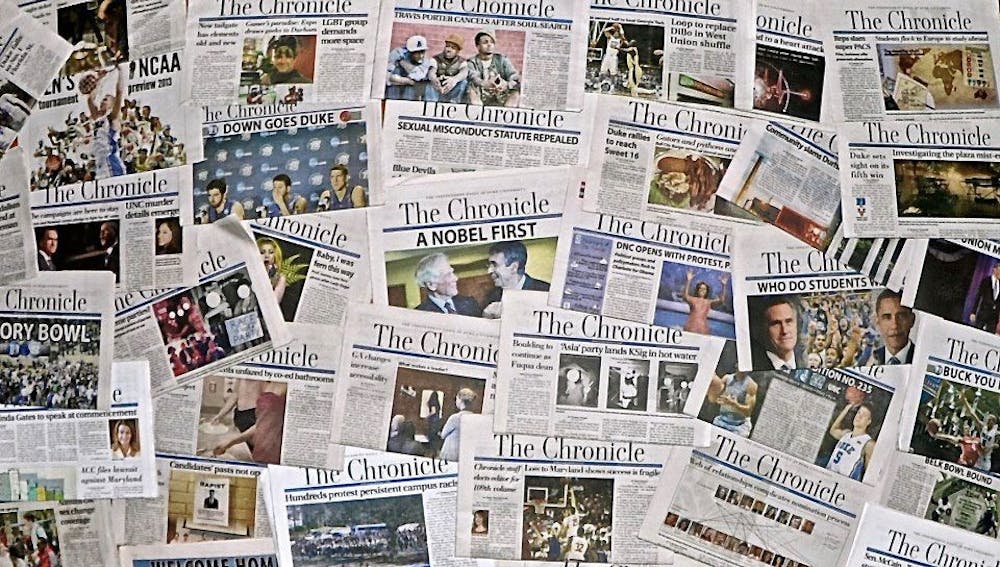The Chronicle will print issues three days per week during the upcoming academic year.
This reduction—from four print publications per week for the past three years to three per week this year—represents a shift towards The Chronicle’s digital-first model, explained members of the Duke Student Publishing Company’s board of directors. The student staff and board of directors discussed the possibility of making these changes throughout the past year, and the board voted in favor of cutting a day of print in June. Beginning in August, The Chronicle will print new issues on Mondays, Wednesdays and Fridays each week, although new content will still be published online daily.
The DSPC is the independent, nonprofit organization that The Chronicle has operated under since 1993, when it became financially and editorially independent from the University. The DSPC board of directors, composed of Chronicle alumni, is responsible for setting broad policies of the newspaper.
“The Chronicle has been working hard on transforming from primarily print focused media to digital first media,” said Chrissy Beck, general manager of The Chronicle. “This doesn’t mean print is going away, just evolving over time to appeal to a younger audience who consumes news from a phone or laptop.”
In 2013, The Chronicle first transitioned from printing daily to printing only four out of five days per week, a decision also made in the interest of developing a stronger digital presence and platform.
The board, full-time business staff and student staff of The Chronicle have worked to incorporate the digital first model recently by “investing in new digital products, analyzing readership every year and constantly fine-tuning our strategic plan,” Beck wrote in an email.
Junior Claire Ballentine, editor-in-chief of The Chronicle, explained that cutting one day of print production will allow staff to reallocate time and energy toward generating digital products. Newspapers around the country have had to make similar print-to-digital transitions in recent years.
“We’re going to focus more on our digital first mentality, because people don’t want to wait to hear about news the next day—they want it now and to read it up on our website,” Ballentine explained. “And it allows us to use print for feature stories, long-form stories and gear our attention more toward social media and creating the digital content that we want.”
The Chronicle’s business staff monitors readership patterns and returns, with the general trend in recent years being that the papers are picked up less frequently from their campus drop boxes and that students receive their news mostly online.
“I do worry about [The Chronicle’s] presence on campus in the digital era—I think it’s really good for the Duke campus to see a fresh paper there in the bins as a reminder to catch up on the news,” said board member Scott McCartney, Trinity '82 and a columnist for The Wall Street Journal. “But The Chronicle is a really important source of news for the Duke community and will always have its place. We may have to work a little harder to make it more visible.”
Beck explained that the decision to print one day less per week was not solely or even significantly motivated by finances, given the strong reserve funds The Chronicle has maintained and the small surplus that it has seen each of the past five years.
“We could afford to print four days a week next year, but that’s not the only factor that goes into making this decision,” she added.
Increasing digital revenue from advertising and a focus on fundraising with Chronicle alumni has contributed to the paper currently being in “strong financial shape,” Beck noted.
Board member Eugene Wang—Trinity '10 and a software developer at The New York Times—added that the change will also better prepare students on staff for current jobs in journalism and media by building an important digital skill set.
“On an institutional and missional level, the skills we want to build for the students working on The Chronicle are more digitally oriented because that’s what the world is moving toward and that’s what employers are expecting,” Wang said. “It’s important to emphasize that we’re not ending print. We’re trying to rebalance our focus more towards digital.”
Get The Chronicle straight to your inbox
Signup for our weekly newsletter. Cancel at any time.

